Kepler-452 is a yellow subgiant star located approximately 1,810 light years away in the northern constellation Cygnus (the Swan). With an apparent magnitude of 13.426, it is invisible to the unaided eye. The evolved star hosts an orbiting planet, Kepler-452b, discovered in 2015.
Kepler-452b was the first potentially rocky super-Earth detected orbiting in the habitable zone of a Sun-like star. With a similar orbital distance and period to Earth’s, the extrasolar planet has often been referred to as “Earth 2.0.” It has been targeted by the SETI institute in search of intelligent life outside the solar system.
Star type
Kepler-452 is a yellow subgiant star of the spectral type G5IV. The star has a similar mass and temperature to the Sun, but it is older and more evolved than our host star. It has a mass of 1.037 solar masses and a radius of 1.11 solar radii. With a surface temperature of 5,757 K (compared to the Sun’s 5,772 K), it shines with 1.10 solar luminosities.
The star has an estimated age of around 6 billion years. It has a metallicity of 0.21, which is 162% of the Sun’s metal content.
Kepler-452 is currently on the subgiant branch, an evolutionary stage that comes after the main sequence for low to intermediate-mass stars. The star is running out of hydrogen fuel in its core and slowly evolving to higher luminosities. It will next become a red giant and start fusing helium.
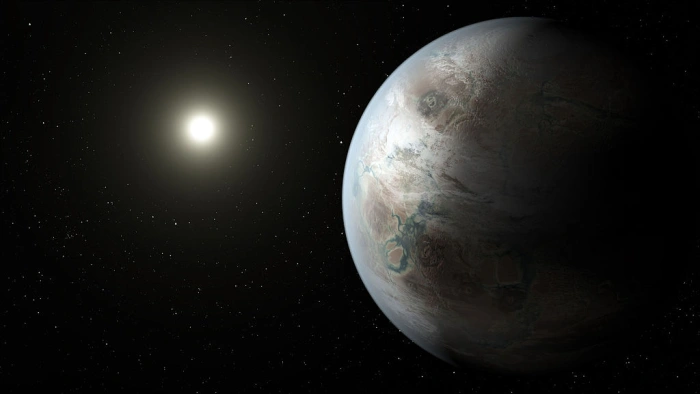
This artist’s concept depicts one possible appearance of the planet Kepler-452b, the first near-Earth-size world to be found in the habitable zone of star that is similar to our Sun. The habitable zone is a region around a star where temperatures are right for water — an essential ingredient for life as we know it — to pool on the surface. Scientists do not know if Kepler-452b can support life or not. What is known about the planet is that it is about 60 percent larger than Earth, placing it in a class of planets dubbed “super-Earths.” While its mass and composition are not yet determined, previous research suggests that planets the size of Kepler-452b have a better than even chance of being rocky. Kepler-452b orbits its star every 385 days. Image credit: NASA Ames/JPL-Caltech/T. Pyle (PD)
Planet
Kepler-452 has an orbiting planet, Kepler-452b, discovered by the Kepler space telescope using the transit method in 2015. The discovery was announced by a team led by the Kepler scientist Jon Jenkins, NASA Ames Research Center, Moffett Field, California, in The Astronomical Journal, on July 23, 2015.
The candidate planet has a mass of 5 ± 2 Earth masses and a radius of 1.5 Earth radii. It orbits the star Kepler-452 with a period of 384.854 days (compared to the Earth’s 365-day orbit around the Sun) at a distance of 1.046 astronomical units (Earth – Sun distances).
Kepler-452b is slightly warmer than Earth. It has an equilibrium temperature of 265 K (-8° C, 17° F). It orbits in the conservative habitable zone of its star, at a distance where liquid water may exist on the planet’s surface. If it is a terrestrial planet, Kepler-452b probably has many active volcanoes because it is denser and more massive than Earth. The surface gravity of Kepler-452b is almost twice as much as our planet’s.
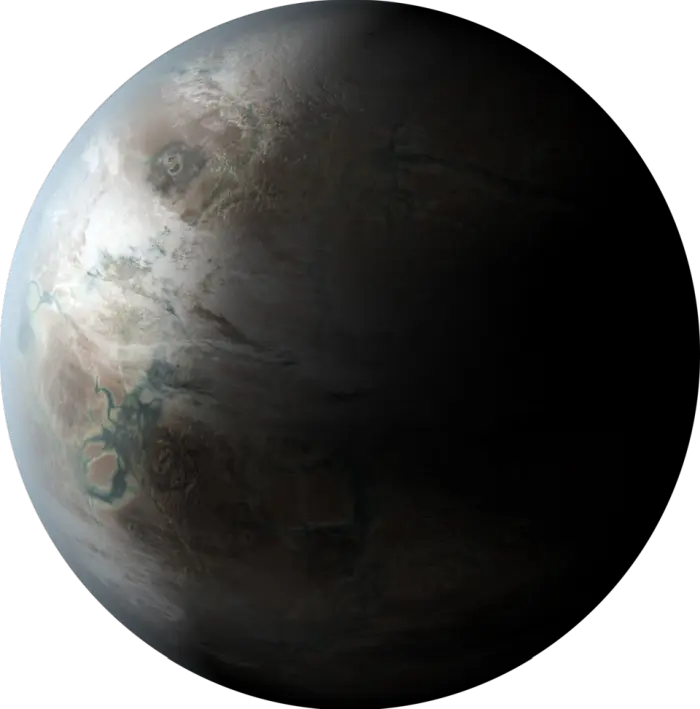
An artist’s concept depicting one possible appearance of the planet Kepler-452b on transparent background. Image credit: NASA Ames/JPL-Caltech/T. Pyle (PD)
The habitability of Kepler-452b is still uncertain. While 6 billion years is more than enough time for complex life to form on the planet, Kepler-452b receives more energy from its host star than Earth does from the Sun. This may cause a runaway greenhouse effect similar to that on Venus. This would occur if the planet’s thick atmosphere contained enough greenhouse gas – gas that traps heat, raising the planet’s surface temperature – that would prevent the surface from cooling and liquid water from forming there.
Kepler-452b may not be a rocky planet at all. Instead, it may be more similar to Neptune. The planet’s true mass and the presence of an atmosphere cannot be determined because the planet lies 1,810 light-years away. A direct mass measurement would allow astronomers to determine the planet’s density and composition.
As the first Earth-like planet discovered in the habitable zone of a star similar to the Sun, Kepler-452b has been studied by scientists at the Search for Extraterrestrial Intelligence Institute (SETI). The researchers have targeted the planet with the Allen Telescope Array, a radio telescope array at the Hat Creek Radio Observatory in California, to look for any radio transmissions from the planet. They have not detected signals that would indicate alien intelligence.
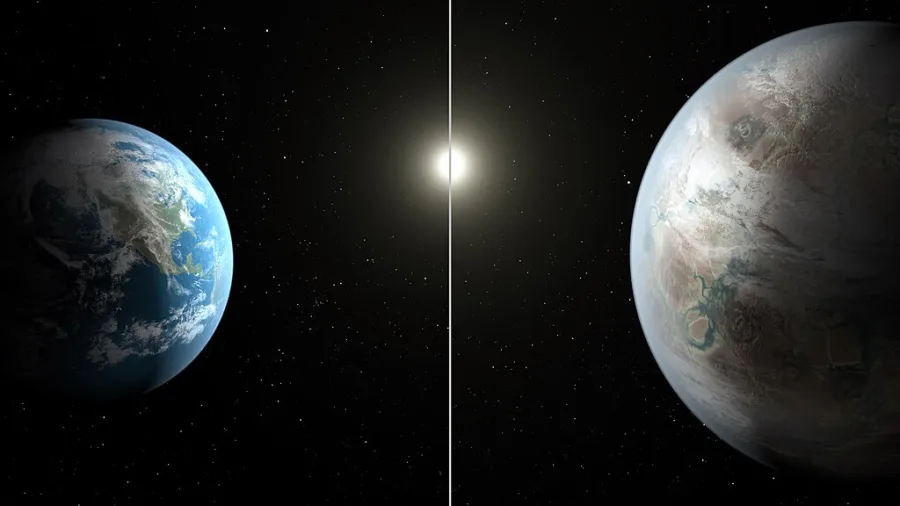
Scientists using data from NASA’s Kepler mission have confirmed the first near-Earth-size planet orbiting in the habitable zone of a Sun-like star. The habitable zone is the region around a star where temperatures are just right for water to exist in its liquid form. The artistic concept compares Earth (left) to the planet Kepler-452b, which is about 50 percent larger. The illustration represents one possible appearance for Kepler-452b — scientists do not know whether the planet has oceans and continents like Earth. Both planets orbit a G2-type star of about the same temperature; however, the star hosting Kepler-452b is 6 billion years old, 1.5 billion years older than our Sun. As stars age, they become larger, hotter and brighter, as represented in the illustration. Kepler-452b’s star appears a bit larger and brighter. Image credit: NASA/Ames/JPL-Caltech/T. Pyle (PD)
Name
The star Kepler-452 does not have a proper name officially approved by the International Astronomical Union (IAU), and it is too faint to have a traditional name. The designation Kepler-452 comes from NASA’s Kepler mission.
Launched in 2009, the Kepler space telescope had a mission to detect Earth-sized planets orbiting in the habitable zones of distant stars. Named after the German astronomer Johannes Kepler, the space telescope discovered more than 2,778 confirmed extrasolar planets before it was retired in 2018.
Kepler-452 was listed as KIC 8311864 in the Kepler Input Catalog. Once Kepler-452b was detected, the star was catalogued as KOI-7016 (Kepler Object of Interest). When the discovery paper was accepted, the star was referred to as Kepler-452 and the newly found planet as Kepler-452b. Kepler-452 was the 452nd star discovered to have a confirmed planet or planetary system during the Kepler mission.
The designation b in Kepler-452b means that this was the first planet detected orbiting the star.
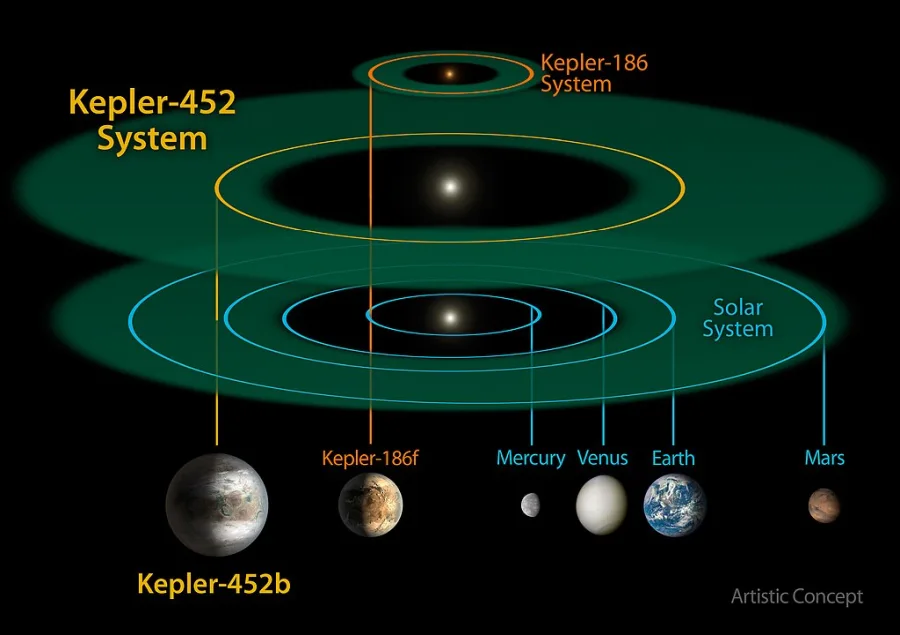
This size and scale of the Kepler-452 system compared alongside the Kepler-186 system and the solar system. Kepler-186 is a miniature solar system that would fit entirely inside the orbit of Mercury. The habitable zone of Kepler-186 is very small compared to that of Kepler-452 or the Sun because it is a much smaller, cooler star. The size and extent of the habitable zone of Kepler-452 is nearly the same as that of the Sun, but is slightly bigger because Kepler-452 is somewhat older, bigger and brighter. The size of the orbit of Kepler-452b is nearly the same as that of the Earth at 1.05 AU. Kepler-452b orbits its star once every 385 days. Image: NASA (PD)
Location
Kepler-452 lies in the region of the Northern Cross, a conspicuous asterism that outlines the body of the celestial Swan (Cygnus). It appears close to Fawaris (Delta Cygni), one of the bright stars that mark the Swan’s wings. Fawaris forms the Northern Cross with Deneb, Sadr, Aljanah, and Albireo. In the northern hemisphere, the asterism appears high overhead in the late summer and early autumn evenings.
At declination +44° 16′, Kepler-452 is best seen from the northern hemisphere. It never rises above the horizon for observers south of the latitude 45° S.
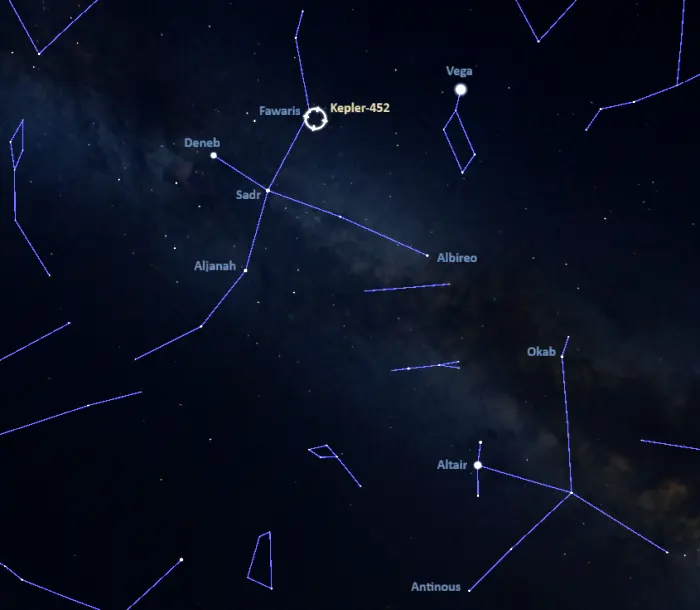
Kepler-452 location, image: Stellarium
Constellation
Kepler-452 is located in the constellation of Cygnus. Cygnus is one of the ancient constellations catalogued by the Greco-Roman astronomer Ptolemy in his Almagest in the 2nd century AD. In Greek mythology, the Swan constellation is associated with the tale of Zeus disguising himself as a swan in order to charm the Spartan queen Leda. Some sources associate the constellation with Cygnus, a friend of Phaethon, the sun of the Sun god Helios, while others link it to the Greek tragic musician and poet Orpheus.
Cygnus stretches across 804 square degrees of the northern sky and is the 16th largest of the 88 modern constellations. Its five brightest stars form the Northern Cross, an asterism that dominates the northern summer and autumn sky.
Deneb (Alpha Cygni), the brightest star in Cygnus, is a blue-white supergiant with an apparent magnitude of 1.25. Located approximately 2,615 light-years away, it is the most distant first magnitude star. It serves as the prototype for a class of variable stars known as the Alpha Cygni variables.
Other bright stars in Cygnus include the yellow-white supergiant Sadr (Gamma Cygni), the orange giant Aljanah (Epsilon Cygni), the orange bright giant Albireo (Beta Cygni), the white subgiant Fawaris (Delta Cygni), the yellow giant Zeta Cygni, and the orange supergiant Xi Cygni.
Cygnus is also home to NML Cygni, one of the largest stars known, the nearby binary star 61 Cygni (Bessel’s Star), the unusual main sequence star known as Tabby’s Star (KIC 8462852), and the luminous blue variable P Cygni. The constellation also contains the Sun-like stars Kepler-22 and Kepler-11, both with confirmed extrasolar planets, and the red dwarf Kepler-186 with a system of five orbiting exoplanets.
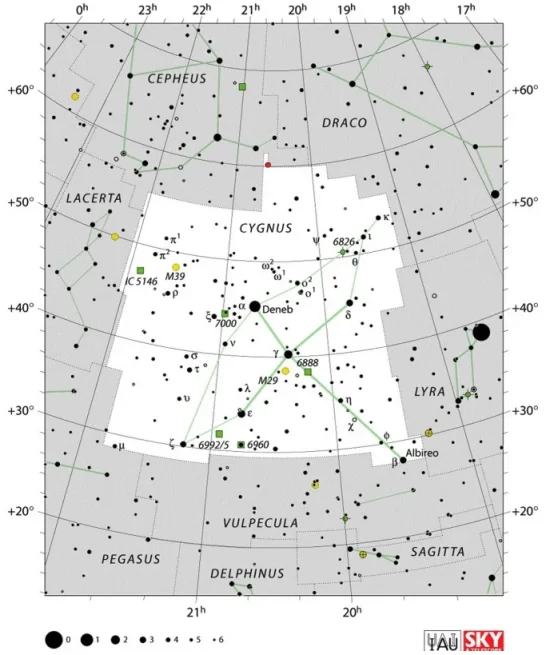
Cygnus constellation map by IAU and Sky&Telescope magazine (Roger Sinnott & Rick Fienberg) (CC BY 3.0)
Cygnus is known for its many relatively bright deep sky objects. These include the open clusters Messier 29, Messier 39 and the Rocking Horse Cluster (NGC 6910), the Fireworks Galaxy (NGC 6946), the North America Nebula (NGC 7000), the Pelican Nebula (IC 5070), the Veil Nebula (Caldwell 33 and Caldwell 34), the Crescent Nebula (NGC 6888), the Sadr Region (IC 1318), and the Blinking Planetary Nebula (NGC 6826).
The constellation also contains the Tulip Nebula (Sh2-101), the Methuselah Nebula (MWP 1), the Cheeseburger Nebula (NGC 7026), the Soccer Ball Nebula (Kronberger 61), the Fetus Nebula (NGC 7008), the Galatic Ghoul (DR 6), and the Footprint Nebula (Minkowski 92).
The best time of the year to see the stars and deep sky objects in Cygnus is during the month of September, when the constellation appears high above the horizon in the early evening. The entire constellation is visible from locations north of the latitude 40° S.
The 10 brightest stars in Cygnus are Deneb (Alpha Cyg, mag. 1.25), Sadr (Gamma Cyg, mag. 2.23), Aljanah (Epsilon Cyg, mag. 2.48), Fawaris (Delta Cyg, mag. 2.87), Albireo (Beta Cyg, mag. 2.90), Zeta Cygni (mag. 3.21), Xi Cygni (mag. 3.73), Tau Cygni (mag. 3.65 – 3.75), Iota2 Cygni (mag. 3.77), and Kappa Cygni (mag. 3.814).
Kepler-452
| Spectral class | G5IV or G4V |
| Apparent magnitude | 13.426 |
| Distance | 1,810 ± 10 light-years (554 ± 3 parsecs) |
| Parallax | 1.8053 ± 0.0103 mas |
| Radial velocity | -42.49 ± 2.33 km/s |
| Proper motion | RA: 9.987 ± 13 mas/yr |
| Dec.: 8.943 ± 14 mas/yr | |
| Mass | 1.037 M☉ (0.99 – 1.091 M☉) |
| Luminosity | 1.10 ± 0.01 L☉ |
| Radius | 1.11 R☉ (1.02 – 1.26 R☉) |
| Temperature | 5,757 ± 85 K |
| Metallicity | 0.21 ± 0.09 dex |
| Age | 6 ± 2 billion years |
| Surface gravity | 4.32 ± 0.09 cgs |
| Constellation | Cygnus |
| Right ascension | 19h 44m 00.8860724760s |
| Declination | +44° 16′ 39.171437292″ |
| Names and designations | Kepler-452, KOI-7016, KIC 8311864, GSC 3148-814, LAMOST J194400.88+441639.2, SPOCS 2400, SPOCS 3104, TIC 272174474, 2MASS J19440088+4416392, Gaia DR2 2079597124345617280, Gaia DR3 2079597124345617280 |